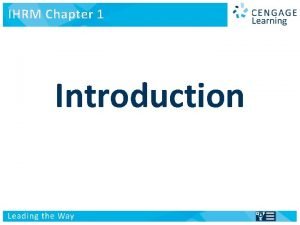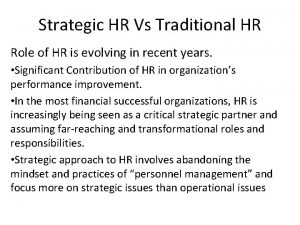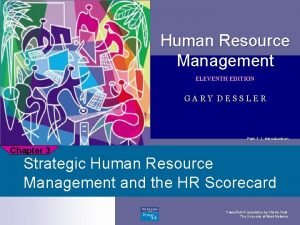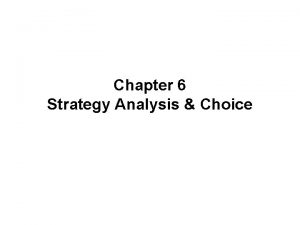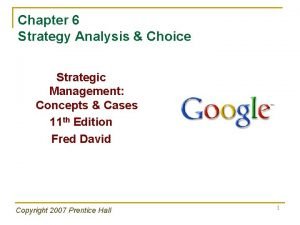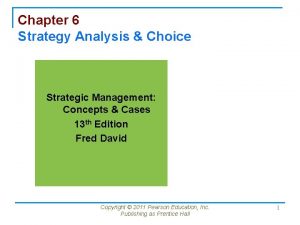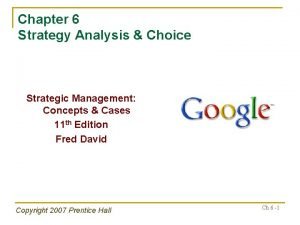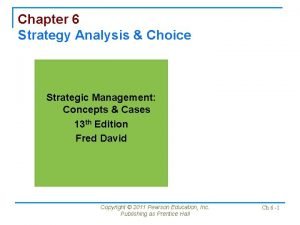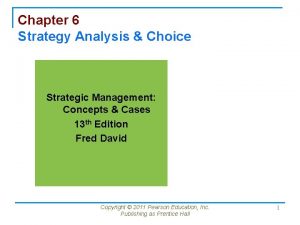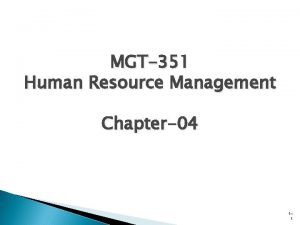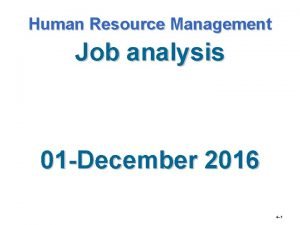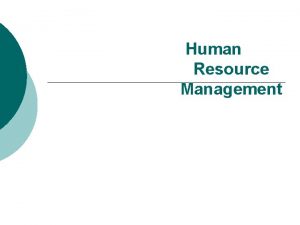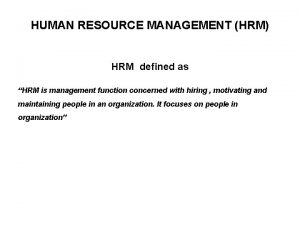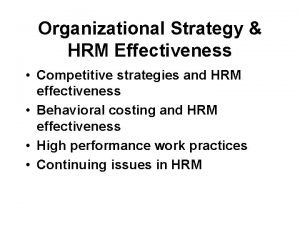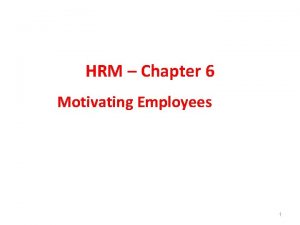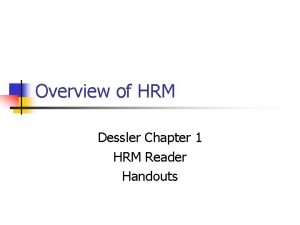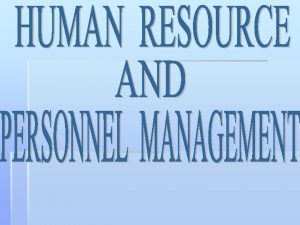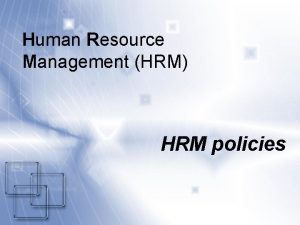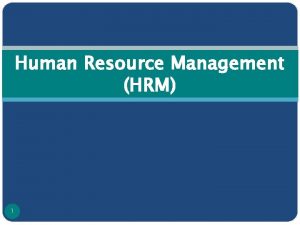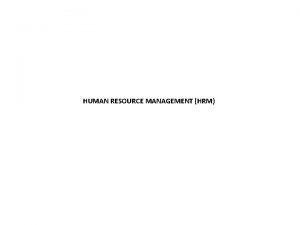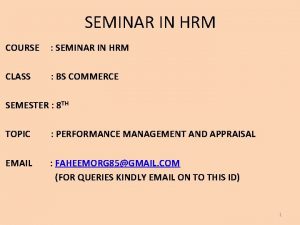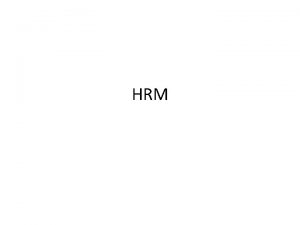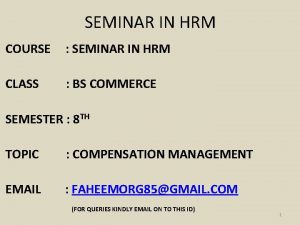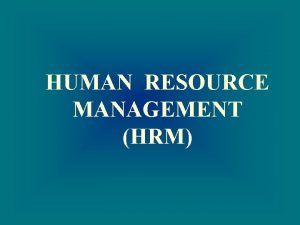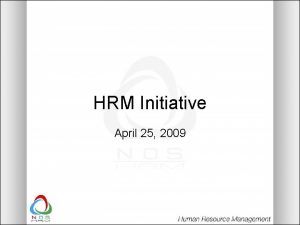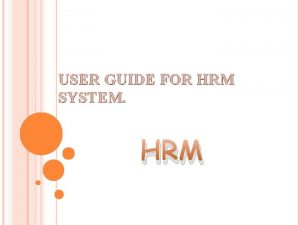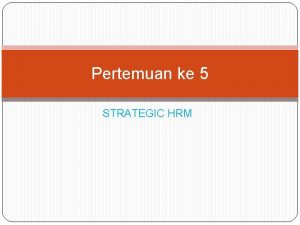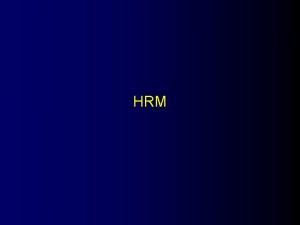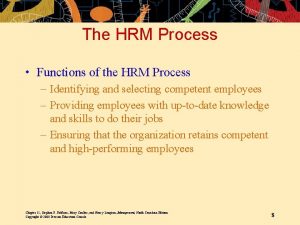HRM STRATEGY AND ANALYSIS LECTURE 2 CHAPTER 3



























- Slides: 27

HRM STRATEGY AND ANALYSIS LECTURE 2 CHAPTER 3

THE STRATEGIC MANAGEMENT PROCESS

THE STRATEGIC MANAGEMENT PROCESS STRATEGIC MANAGEMENT- the process of identifying and executing the organisation’s strategic plan by matching the company’s capabilities with the demands of its environment. STRATEGIC PLAN- the company’s plan for how it will match its internal strengths and weaknesses with external opportunities and threats in order to maintain a competitive advantage.

THE STRATEGIC MANAGEMENT PROCESS Step 1: Define the current business Step 2: Perform external and internal audits Step 5: Formulate strategies to achieve the strategic goals Step 3: Formulate a new direction Step 6: Implement the strategies Step 4: Translate the mission into strategic goals Step 7: Evaluate performance

THE STRATEGIC MANAGEMENT PROCESS 1. What business are we in? 2. Are we in the right business given our strengths and weaknesses and the challenges that we face? 3. What should our new business be? 4. Translate the desired new direction into strategic goals 5. Choose strategies that will enable the company to achieve its goals 6. Strategy execution 7. The manager evaluates the results of his or her planning and execution

TYPES OF STRATEGIES 1. Corporate Strategies 2. Business Strategies 3. Functional Strategies

CORPORATE STRATEGY • Type of strategy that identifies the portfolio of businesses that, in total, comprise the company and the ways in which these businesses relate to each other.

CORPORATE STRATEGY • Concentration Corporate Strategy- the company offers one product or product line, usually in one market. • Diversification Corporate Strategy- the firm will expand by adding new product lines. • Vertical Integration Corporate Strategy- the firm expands by, perhaps, producing its own raw materials or selling its products directly.

CORPORATE STRATEGY • Consolidation Corporate Strategy- the company reduces its size. • Geographic Expansion- the company grows by entering new territorial markets.

COMPETITIVE STRATEGY A strategy that identifies how to build and strengthen the business’s long-term competitive position in the marketplace.

TYPES OF COMPETITIVE STRATEGY • 1. Cost Leadership- low cost industry leader. • 2. Differentiation- unique dimension to their products/services. • 3. Focusers- market niche.

FUNCTIONAL STRATEGIES • A strategy that identifies the broad activities that each department will pursue in order to help the business accomplish its competitive goals.

STRATEGIC HUMAN RESOURCE MANAGEMENT

• Formulating and executing human resource policies and practices that produce the employee competencies and behaviours the company needs achieve its strategic aims.

STRATEGIC HUMAN RESOURCE MANAGEMENT TOOLS • STRATEGY MAP A strategic planning tool that shows the “big picture” of how each department’s performance contributes to achieving the company’s overall strategic goals.

STRATEGIC HUMAN RESOURCE MANAGEMENT TOOLS • HR SCORECARD A process for assigning financial and nonfinancial goals or metrics to the human resource management-related chain of activities required for achieving the company’s strategic aims and for monitoring results.

STRATEGIC HUMAN RESOURCE MANAGEMENT TOOLS • DIGITAL DASHBOARD Presents the manager with desktop graphs and charts, and so a computerised picture of where the company stands on all those metrics from the HR scorecard process

HR METRICS BENCHMARKING & DATA ANALYTICS • HR METRICS The quantitative gauge of a human resource management activity, such as employee turnover, hours of training per employee, or qualified employees per position.

STRATEGY-BASED METRICS • Metrics that specially focus on measuring the activities that contribute to achieving a company’s strategic aims.

HR AUDIT • An analysis by which an organisation measures where it currently stands and determines what it has to accomplish to improve its HR functions.

HIGH-PERFORMANCE WORK SYSTEM (HPWS) • A HPWS is a set of HRM policies and practices that together produce superior employee performance. • Example- HP companies recruit more job candidates, use more selection tests, and spend many hours training employees.

STRATEGIC PRIORITIES • INNOVATION • BRAND • PRICE • DESIGN • QUALITY





 Difference between domestic hrm and ihrm
Difference between domestic hrm and ihrm Strategic hr and traditional hr
Strategic hr and traditional hr 01:640:244 lecture notes - lecture 15: plat, idah, farad
01:640:244 lecture notes - lecture 15: plat, idah, farad Shrm vs hrm
Shrm vs hrm Consolidation strategy in hrm
Consolidation strategy in hrm Chapter 6 strategy analysis and choice
Chapter 6 strategy analysis and choice The nature of strategy analysis and choice
The nature of strategy analysis and choice Chapter 6 strategy analysis and choice
Chapter 6 strategy analysis and choice What are the two external dimensions of the space matrix?
What are the two external dimensions of the space matrix? Matching stage of strategy formulation framework
Matching stage of strategy formulation framework Chapter 6 strategic management
Chapter 6 strategic management 8 steps of job analysis
8 steps of job analysis What is markov analysis in human resource planning
What is markov analysis in human resource planning Discovering unassigned duties
Discovering unassigned duties Job analysis
Job analysis Corporate strategy and business strategy
Corporate strategy and business strategy Chase strategy adalah
Chase strategy adalah Chapter 1 hrm in a changing environment
Chapter 1 hrm in a changing environment Hrm chapter 2
Hrm chapter 2 Hrm chapter 1
Hrm chapter 1 Exploratory data analysis lecture notes
Exploratory data analysis lecture notes Sensitivity analysis lecture notes
Sensitivity analysis lecture notes Factor analysis lecture notes
Factor analysis lecture notes Analysis of algorithms lecture notes
Analysis of algorithms lecture notes Tiu lecture notes medical analysis
Tiu lecture notes medical analysis Zline 667-36
Zline 667-36 Global matrix structure
Global matrix structure Multidomestic corporation
Multidomestic corporation
